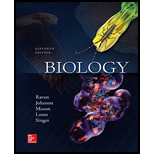
Concept explainers
Nonnative invasive species are often a threat to native species because they
a. typically grow larger than other plants.
b. are not susceptible to any diseases.
c. are
d. do not have natural enemies in their new location.
Introduction:
The invasive species can be defined as the plant, animal or fungus that is not the natural habitat of a specific location; however, they are introduced and spread to a greater extent. This greater expansion leads to damage to the environment and a threat to the native species.
Answer to Problem 1U
Correct answer:
The non-native invasive species do not have enemies in their new location and this account for threat to the native species. Therefore, option d. is correct.
Explanation of Solution
Reason for the correct statement:
The non-native invasive species poses more threat to the invasive species because the native species have natural attackers and enemies. The non-native invasive species are new to the location and hence, there is no threat of attackers for them. They possess a more risk because they lack natural predators in the new location.
Option d. is given as “do not have natural enemies in their new location”.
As, “the non-native invasive plants do not have any natural predators in their new environment, they possess a threat to the native species”, is the right answer.
Hence, option d. is correct.
Reasons for the incorrect statements:
Option a. is given as “typically grow larger than other plants”.
The size of the non-native invasive species does not possess a threat to the native species. So, it is a wrong answer.
Option b. is given as “are not susceptible to any diseases”.
The non native invasive species are the normal living organisms and they suffer from diseases. So, it is a wrong answer.
Option c. is given as “are parasitic”.
The non-native invasive species are not parasitic rather most of them are free-living. So, it is a wrong answer.
Hence, options a., b., and c. are incorrect.
The non-native invasive species are the plants, animals or fungus, which are introduced into a new environment and they are not the natural inhabitants of that location. They lack natural enemies in their new environment and hence, their growth rate are very high.
Want to see more full solutions like this?
Chapter 39 Solutions
Biology
- Kangaroo rats are keystone species because _______________________________. a. the seeds they eat or don't eat determine the vegetative landscape. b. their habitats also provide refuge for other organisms. c. the animals they prey upon are herbivores, which impact the landscape d. their feeding behaviors influence the local climate, which determines which plants can grow.arrow_forwardThe impacts on fire regimes in the US is strongly correlated with the change in priority given to cultural, regulating, provisioning and supporting ecosystem services. A. How did those priorities change? explain using examples B. What did that change in priority do to fire regimes present and future? C. will the changes in fire regimes benefit fire dependent or fire tolerant species? explain your reasoning, use examples)arrow_forwardConverting a prairie to a farm field is an example of _________. a. overharvesting b. habitat loss c. exotic species d. climate changearrow_forward
- Deforestation ______. a. increases mineral runoff from soil b. decreases local temperature c. increases local rainfall d. all of the abovearrow_forwardPrimary”succession is succession that:a.involves establishment of primary producers where there were none.b.leads to establishment of a climax community dominated by primaryproducers.c.occurs on newly exposed geologic substrates, not organic soil.d.occurs where organic soils have been exposed but not destroyed bydisturbance.e.occurs after fire or agricultural abandonment.arrow_forwardThe ability of an ecosystem to return to its equilibrium state after an environmental disturbance is called ________. a. resistance b. restoration c. reformation d. resiliencearrow_forward
- Which of these hypotheses does not explain why increased CO2 levels in the atmosphere could cause a decrease in the productivity of some crops because of changes in climate? A) There could be increases in average winter temperatures that reduce the growth of crops. B) There could be decreases in precipitation in some regions that reduce growth in some crops. C) There could be shifts in the ranges of some important species in the community, such as pollinators, that cause reduction of growth in some crops.arrow_forwardIn a tropical rainforest, an open gap lacking vegetation has been created by the fall of a large tree. Which of the following statements describes the characteristics of the plant species that are last to colonize this disturbed habitat? a. they have low reproductive rates and are good competitors b. they are good colonizers c. they have high reproductive rates and are poor competitors d. they are dominated by r-selected species e. they have high species diversityarrow_forwardWhich of the following is a negative consequence associated with both slash-and-burn and monoculture? a) Decreased yield b) Increased pollution c)Ecosystem disruption d)Reduced biodiversityarrow_forward
- A community in which secondary succession is very rapid has: a) High resilience b) Low resistance c) High resistance d) Low resiliencearrow_forwardThrough succession, a field becomes a forest as hardwood trees become the dominant species in the ecosystem. Grasses are no longer able to compete as well in the forested environment. grasses → shrubs → softwood trees → hardwood trees Which is most likely the limiting factor that inhibits the growth of the grasses in the forest? a slow rates of decomposition on the forest floor b low levels of sunlight reaching the forest floor c thin layers of topsoil on the forest floor d low levels of humidity near the forest floorarrow_forwardWhich is NOT a downside to the loss of crop diversity? A. More vulnerability to pests/diseases. B. Loss of consumer options. C. Lower nutritional value. D. Lower availability of corn and wheat.arrow_forward
 Concepts of BiologyBiologyISBN:9781938168116Author:Samantha Fowler, Rebecca Roush, James WisePublisher:OpenStax College
Concepts of BiologyBiologyISBN:9781938168116Author:Samantha Fowler, Rebecca Roush, James WisePublisher:OpenStax College Human Biology (MindTap Course List)BiologyISBN:9781305112100Author:Cecie Starr, Beverly McMillanPublisher:Cengage Learning
Human Biology (MindTap Course List)BiologyISBN:9781305112100Author:Cecie Starr, Beverly McMillanPublisher:Cengage Learning


